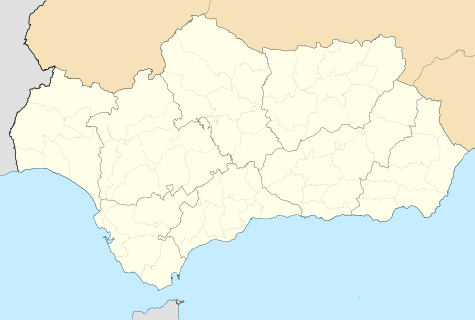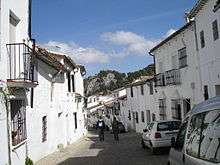Grazalema
| Grazalema | ||
|---|---|---|
| Municipality | ||
|
Grazalema seen from the Sierra del Endrinal | ||
| ||
.png) Location of Grazalema in the province of Cádiz. | ||
 Grazalema Location in Andalusia | ||
| Coordinates: 36°46′N 5°22′W / 36.767°N 5.367°W | ||
| Country |
| |
| Autonomous community |
| |
| Province | Cádiz | |
| Comarca | Sierra de Cádiz | |
| Government | ||
| • Mayor | María José Lara Mateos (PSOE) | |
| Area | ||
| • Total | 122.41 km2 (47.26 sq mi) | |
| Elevation | 812 m (2,664 ft) | |
| Population (2009) | ||
| • Total | 2,205 | |
| • Density | 18/km2 (47/sq mi) | |
| Demonym(s) | Grazalemeños | |
| Time zone | CET (UTC+1) | |
| • Summer (DST) | CEST (UTC+2) | |
| Postal code | 11610 | |
| Website | Official website | |
Grazalema is a village located in the northeastern part of the province of Cádiz, in the autonomous community of Andalusia, Spain. Situated in the foothills of the Sierra del Pinar mountain range (Sierra de Grazalema Natural Park), Grazalema had, as of 2009, a population of 2,205.
History
The Roman villa of Lacidulia or Lacidulerium,[1] situated in an estate near to the present village, has been traditionally considered the ancestor of Grazalema.
During Muslim rule in the 8th century, these lands were populated by people of Berber origin and from them, the area acquired the name of Raisa lami Suli, “town of the Banu al-Salim”, place which passed to Ben-salama, “Son of Zulema and later Grand Zulema”. During this period, its economy was organised around forestry, agriculture, farming and textile manufacture.
With the Christian conquest in 1485, Zagrazalema, as it was called at the time, became part of the lands of the Rodrigo Ponce de León y Núñez. It became economically important as of the 17th century thanks to the drapery industry which produced the famous shawls of Grazalema. In the first years of the 19th century, during the War of Independence, Grazalema suffered attacks and sieges from the Napoleonic troops who partially destroyed the village.
Main sights

- Hermitage of the Sain
- Town Hall palace
- Parish church of the Incarnation (17 to 19th century)
- Church of Our Lady of Aurora, in Baroque style (18th century)
- Museums: Cloak factory, Our Lady of Carmen, textile handicraft
Economy
Traditionally, the economy of the village was generated by small-scale agriculture, sheep herding, cork harvesting, and handicrafts, like hand-weaving lambswool cloth and furniture-making. These activities are now quite limited and under-resourced. Due to the location of Grazalema in the middle of the Sierra de Grazalema Natural Park and the fact that the town is one of the pueblos blancos, the so-called White Towns of Andalusia, tourism now plays a major role in sustaining the village and its people. The mountainous area around Grazalema is popular with climbers and hikers, and local people make money by providing accommodations and hospitality to visitors.
Events
The first fiesta is the Romería of San Isidro Labrador which is held on the last Sunday in May (celebrating the arrival of summer). On 13 June, the village celebrates Benamahoma, the fiesta in honor of its patron, San Antonio. During the third week of July, the Fiestas of Carmen are held which climax with the Monday of Bulls. The first Sunday in August, Benamahoma celebrates the festival of Moors and Christians. The most important agricultural festivals in Grazalema are held during the third week in August. The eighth day of September is the day of the Virgin of the Angeles, who is the patron saint of Grazalema. The first weekend in October is the festival Sangre y Amour en la Sierra, a costumed recreation of the story of Tempranillo and his wife, Maria Jeronima.
In popular culture
Some scenes in the Spanish horror movie Una vela para el diablo (1973) were shot in Grazalema.
See also
References
- ↑
 Baynes, T.S.; Smith, W.R., eds. (1880). "Grazalema". Encyclopædia Britannica. 11 (9th ed.). p. 78.
Baynes, T.S.; Smith, W.R., eds. (1880). "Grazalema". Encyclopædia Britannica. 11 (9th ed.). p. 78.
External links
| Wikimedia Commons has media related to Grazalema. |
- Grazalema Guide Information about Grazalema and surrounding areas.
- Grazalema Tourist Information Information about Grazalema and surrounding areas (in Spanish, English, German and French)
- Grazalema Andalusian statistical information system

